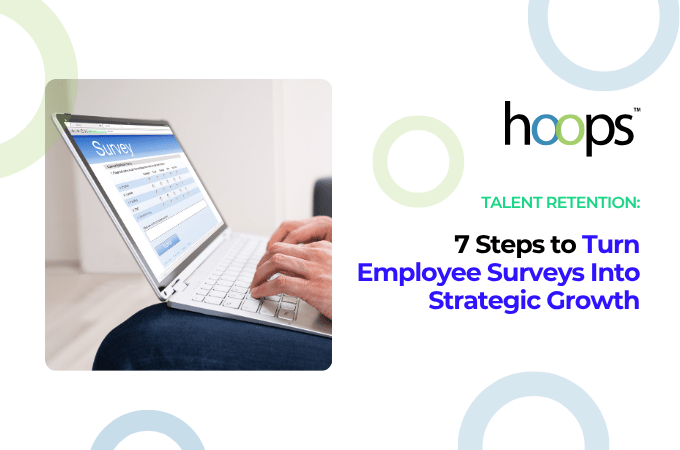Introduction: Feedback That Moves the Needle
Too many companies treat employee surveys as a routine checkbox. But the best leaders know better.
Employee surveys—when done right—offer real-time insight into the health of your workforce and the roadblocks in your way. They help you see what’s fueling performance, what’s draining it, and where to act next.
In a fast-moving, high-growth environment, clear feedback loops are essential. With the right strategy behind them, employee surveys can:
- Improve retention and engagement
- Catch early signs of burnout or turnover
- Strengthen team alignment and culture
- Help you scale with greater clarity and fewer missteps
Let’s walk through how to make employee surveys a core part of your leadership toolkit.
Why Employee Surveys Matter Now More Than Ever
According to Gallup’s Global Workplace Report, only 23% of employees are engaged at work globally, and disengagement costs the world economy $8.8 trillion annually (that’s not a typo).
Well-designed employee surveys give leaders a window into what employees are actually experiencing day to day. They:
-
Surface issues before they become problems
-
Show trends over time, across roles, teams, or tenures
-
Offer data you can act on—not just anecdotes
And it’s not just an HR function. According to Mercer’s 2024 Global Talent Trends report, 89% of asset managers say an engaged workforce directly drives company value.
The takeaway? If you want to grow your business, you need to listen on purpose—and act with clarity.
The 6 Types of Employee Surveys Every Scaling Company Should Use
Not all surveys serve the same purpose. Here are six worth implementing:
1. Engagement Surveys
Used to understand how connected employees feel to their work, team, and the broader mission. These surveys help you measure morale, motivation, and alignment—all critical to retention and performance.
2. Onboarding Surveys
Sent within the first 30–90 days of employment to assess whether new hires feel supported and clear on their role. Insights help identify early friction points in your hiring, training, or team integration.
3. Pulse Surveys
Short and recurring (weekly or monthly), these check-ins give a quick snapshot of how people are feeling right now. Useful for spotting real-time issues or measuring reactions to recent changes.
4. Culture/Experience Surveys
These dive deeper into how well your values show up day-to-day. They explore leadership trust, communication effectiveness, collaboration, and inclusivity—shaping how people show up and stay.
5. Wellbeing Surveys
Focused on mental, emotional, and workload health. These surveys help flag burnout risks, work-life imbalance, or stress before they impact productivity or cause turnover.
6. Exit Surveys
Conducted when someone resigns, these provide candid feedback on why they’re leaving—and what could have made them stay. Patterns here reveal broader retention gaps or manager-level issues.
Each survey creates an opportunity to understand, improve, and grow. Used together, they give you a comprehensive view of your workforce health.
7 Steps to Turn Employee Surveys Into Strategy
Sending a survey is simple. Turning that feedback into a roadmap for stronger performance? That takes structure.
Here’s how to turn employee surveys into a practical, results-driven process that contributes directly to retention, performance, and organizational growth:
Step 1: Target Bottlenecks With Purpose
Start every survey with a business challenge in mind. Are you losing new hires before Day 90? Is productivity dipping in specific teams? Let that hypothesis guide your survey design.
Surveys aligned to real challenges produce focused insights and faster results.
Step 2: Design Questions That Drive Decisions
Good data starts with good questions. Align each one to a decision you’re trying to make. Mix scaled and open-ended formats for both clarity and context. For example:
- On a scale of 1–10, how confident are you in your role expectations?
- What’s one thing we could improve about team communication?
Clear, purposeful design gives you insights you can actually act on.

Step 3: Automate for Consistency and Scale
Tech isn’t just about saving time—it’s about driving consistency, accountability, and scale. It eliminates friction, reduces error, and ensures nothing slips through the cracks. Smart automation workflows can:
- Trigger surveys at key lifecycle moments (onboarding Day 30, exit interviews, etc.)
- Send personalized reminders to improve completion rates
- Capture, timestamp, and organize feedback data for easy filtering and trend analysis
- Spot recurring issues, such as declining team morale or low scores for specific managers
Automated workflows surface problems faster, so leaders can act early instead of react late.
Step 4: Break It Down by Group
Don’t stop at the company average. Segment results by role, department, tenure, manager, and location. Ask:
- Are first-year employees scoring lower on manager support?
- Are remote teams less connected than in-office ones?
Segmented insights lead to tailored solutions. This allows you to direct budget, support, and changes to the teams or roles where it will have the most impact.
Step 5: Show People That It Mattered
When employees take the time to offer feedback, they’re expecting more than silence. Share back the high-level findings and next steps. Even if the change is small, communicating it reinforces that feedback drives progress. Plus, this improves future participation, builds trust, and increases employee loyalty.
Step 6: Take Action (Even Small Ones)
You don’t need to fix everything at once. Choose 1–2 focus areas. Example: improving clarity in job expectations or reducing unnecessary meetings. Use sprints: 30/60/90-day actions with a clear owner and outcome. Communicate progress. Make change visible.
Teams that see consistent follow-through are more likely to stay and perform at a higher level.
Step 7: Build a Habit
Treat feedback like any other critical business input—recurring, structured, and strategic. Build a rhythm that gives you ongoing insight without overwhelming your team:
- Monthly: 1–2 question pulse checks for quick signals
- Quarterly: Key focus area deep dives (e.g., culture/experience, onboarding, recognition, etc.)
- Annually: Comprehensive engagement surveys that inform your strategic talent planning
With a cadence in place, ongoing listening and action turn your workforce into a real-time growth indicator and decision-making tool.
How Hoops Makes This Seamless
At Hoops, we’ve built survey automation right into our Talent Experience Platform so it’s simple to keep your finger on the pulse—without adding more to your plate.
We help companies:
- Trigger employee surveys automatically at key milestones (onboarding, exit, mid-year, etc.)
- Customize questions by role or goal
- Track response rates, identify trends, and visualize key themes
- Connect survey data to larger talent goals like retention, productivity, and performance
Our team doesn’t just hand you the results—we help interpret what it means and where to go from here.
Whether you’re starting from zero or refining existing efforts, we’ve got playbooks, templates, and expert support to help you turn listening into action.
What Strategic Survey Use Looks Like
Before we wrap, here’s what a strong, growth-oriented survey strategy should produce:
- You identify red flags and turnover risks 3–6 months sooner
- Your engagement scores trend upward—and tie back to productivity
- Managers lead proactively based on insights—not reactively based on complaints
Final Thoughts: Insight Is Only Powerful If You Use It
Many leaders say they value employee feedback. Fewer have a plan to act on it.
When employee surveys are structured, analyzed, and followed up with care, they don’t just improve culture—they improve business outcomes.
They help you:
- Retain top performers
- Strengthen manager effectiveness
- Support employees before they burn out
- Scale with fewer blind spots
Want a quick way to assess where you stand?
Try our free Talent Health Checkup—a quick scan to spot risks, surface gaps, and help you build the team your growth deserves.
Build Your Winning Team. Hire and Scale Talent.







